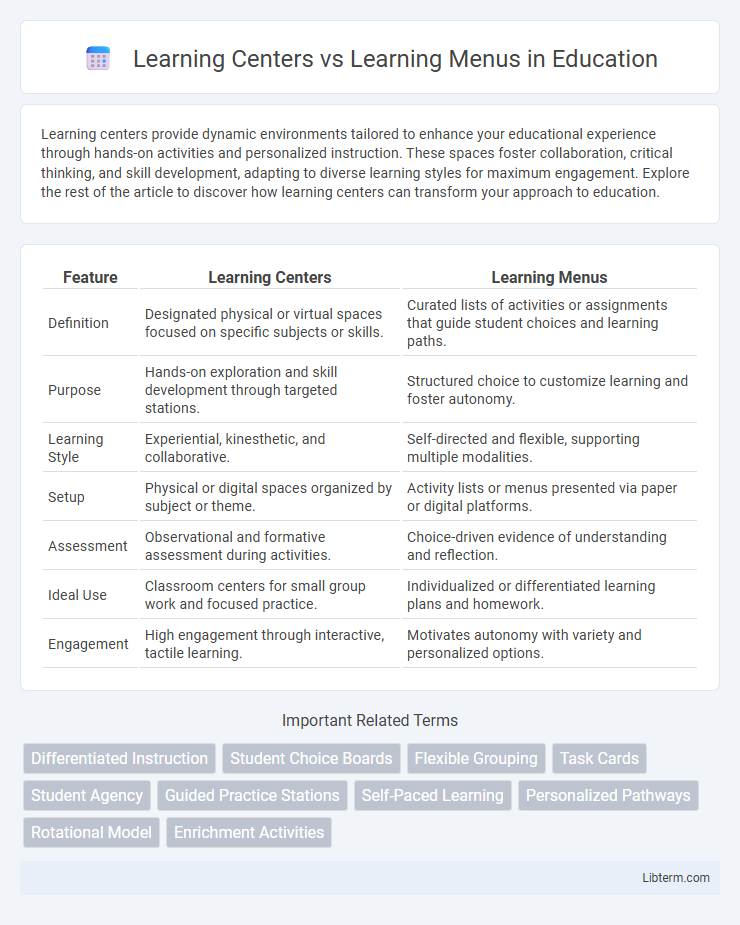Learning centers provide dynamic environments tailored to enhance your educational experience through hands-on activities and personalized instruction. These spaces foster collaboration, critical thinking, and skill development, adapting to diverse learning styles for maximum engagement. Explore the rest of the article to discover how learning centers can transform your approach to education.
Table of Comparison
| Feature | Learning Centers | Learning Menus |
|---|---|---|
| Definition | Designated physical or virtual spaces focused on specific subjects or skills. | Curated lists of activities or assignments that guide student choices and learning paths. |
| Purpose | Hands-on exploration and skill development through targeted stations. | Structured choice to customize learning and foster autonomy. |
| Learning Style | Experiential, kinesthetic, and collaborative. | Self-directed and flexible, supporting multiple modalities. |
| Setup | Physical or digital spaces organized by subject or theme. | Activity lists or menus presented via paper or digital platforms. |
| Assessment | Observational and formative assessment during activities. | Choice-driven evidence of understanding and reflection. |
| Ideal Use | Classroom centers for small group work and focused practice. | Individualized or differentiated learning plans and homework. |
| Engagement | High engagement through interactive, tactile learning. | Motivates autonomy with variety and personalized options. |
Introduction to Learning Centers and Learning Menus
Learning Centers are designated physical or virtual spaces designed to provide targeted educational activities that foster hands-on engagement and individualized learning. Learning Menus offer a structured framework that presents students with a variety of task options, allowing choice and promoting autonomy in skill development and content mastery. Both tools enhance differentiated instruction by catering to diverse learning styles and encouraging active participation.
Defining Learning Centers
Learning Centers are designated physical or virtual spaces designed to facilitate hands-on, interactive learning experiences tailored to specific subjects or skills. These centers provide structured activities and resources that promote exploration, collaboration, and mastery through self-paced or guided tasks. Unlike Learning Menus, which offer choices of assignments or topics, Learning Centers emphasize environment setup to encourage immersive, experiential learning.
Understanding Learning Menus
Learning Menus offer a structured yet flexible approach to student choice by providing a curated list of learning activities aligned with specific objectives, enabling personalized pacing and mastery-based progression. Unlike Learning Centers, which are physical or virtual spaces designated for exploration and skill practice, Learning Menus function as curated guides that promote autonomy, engagement, and differentiated instruction within various educational settings. The strategic design of Learning Menus facilitates targeted skill development by allowing learners to select tasks that match their interests and proficiency levels, thereby enhancing motivation and deeper understanding.
Core Differences Between Learning Centers and Menus
Learning Centers provide a physical or virtual space where students engage with hands-on materials and activities designed for exploration and self-paced learning. Learning Menus offer a structured list of differentiated tasks or options that guide students through specific skills or concepts, allowing for choice within a predefined framework. Core differences include the emphasis on experiential, interactive engagement in Learning Centers versus the organized, goal-oriented approach of Learning Menus.
Benefits of Learning Centers in the Classroom
Learning centers promote hands-on engagement and personalized learning by allowing students to explore concepts independently or in small groups. They foster collaboration, critical thinking, and cater to diverse learning styles by offering varied, interactive materials. This approach enhances student motivation, retention, and autonomy, making learning more dynamic and effective in the classroom.
Advantages of Using Learning Menus
Learning Menus offer personalized learning paths by allowing students to choose tasks that match their interests and skill levels, increasing engagement and motivation. They promote autonomy and self-paced learning, enabling learners to manage their time and focus on areas needing improvement. The flexibility and variety within Learning Menus support diverse learning styles and enhance differentiation in instructional design.
Challenges and Limitations of Each Approach
Learning Centers often face challenges related to space constraints and resource allocation, limiting the variety of activities available to students. Learning Menus can overwhelm learners with too many choices, potentially causing decision fatigue and reducing focus on core skills. Both approaches require careful planning to balance engagement with effective learning outcomes.
Student Engagement: Centers vs. Menus
Learning Centers provide hands-on, interactive activities designed to immerse students in collaborative and experiential learning, boosting engagement through tactile and social experiences. Learning Menus offer students choice-driven tasks that cater to diverse learning styles, enhancing motivation by allowing autonomy and personalized pacing. Both methods increase student engagement by promoting active participation, but Centers emphasize physical interaction while Menus focus on self-directed exploration.
Choosing the Right Approach for Your Classroom
Learning centers offer immersive, hands-on experiences that cater to different learning styles by providing dedicated spaces for specific skills. Learning menus provide structured choices, allowing students to select tasks that match their interests and pace while ensuring curriculum alignment. Selecting the right approach depends on classroom dynamics, student autonomy needs, and the balance between guided instruction and independent exploration.
Conclusion: Maximizing Student Choice and Differentiation
Learning Centers and Learning Menus both enhance student choice and differentiation by providing varied pathways for engagement tailored to individual learning styles. Learning Centers offer hands-on, activity-based environments that foster collaboration and experiential learning, while Learning Menus allow students to select tasks based on interest and skill level, promoting autonomy and personalized pacing. Combining these approaches maximizes flexibility, supports diverse learners, and drives deeper mastery through self-directed exploration and targeted practice.
Learning Centers Infographic

 libterm.com
libterm.com